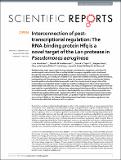Interconnection of post-transcriptional regulation: The RNA-binding protein Hfq is a novel target of the Lon protease in Pseudomonas aeruginosa
Author(s)
Fernández, Lucía; Breidenstein, Elena B. M.; Taylor, Patrick K.; Bains, Manjeet; Fang, Yuan; Foster, Leonard J.; Hancock, Robert E. W.; de la Fuente Nunez, Cesar; ... Show more Show less
DownloadInterconnection of.pdf (706.4Kb)
PUBLISHER_CC
Publisher with Creative Commons License
Creative Commons Attribution
Terms of use
Metadata
Show full item recordAbstract
Besides being a major opportunistic human pathogen, Pseudomonas aeruginosa can be found in a wide range of environments. This versatility is linked to complex regulation, which is achieved through the action of transcriptional regulators, and post-transcriptional regulation by intracellular proteases including Lon. Indeed, lon mutants in this species show defects in motility, biofilm formation, pathogenicity and fluoroquinolone resistance. Here, the proteomic approach stable isotope labeling by amino acids in cell culture (SILAC) was used to search for novel proteolytic targets. One of the proteins that accumulated in the lon mutant was the RNA-binding protein Hfq. Further experiments demonstrated the ability of Lon to degrade Hfq in vitro. Also, overexpression of the hfq gene in the wild-type strain led to partial inhibition of swarming, swimming and twitching motilities, indicating that Hfq accumulation could contribute to the phenotypes displayed by Lon mutants. Hfq overexpression also led to the upregulation of the small regulatory RNA PhrS. Analysis of the phenotypes of strains lacking or overexpressing this sRNA indicated that the Lon protease might be indirectly regulating the levels and activity of sRNAs via Hfq. Overall, this study revealed new links in the complex regulatory chain that controls multicellular behaviours in P. aeruginosa.
Date issued
2016-05Department
MIT Synthetic Biology Center; Massachusetts Institute of Technology. Department of Biological Engineering; Massachusetts Institute of Technology. Department of Electrical Engineering and Computer Science; Massachusetts Institute of Technology. Research Laboratory of ElectronicsJournal
Scientific Reports
Publisher
Nature Publishing Group
Citation
Fernández, Lucía et al. “Interconnection of Post-Transcriptional Regulation: The RNA-Binding Protein Hfq Is a Novel Target of the Lon Protease in Pseudomonas Aeruginosa.” Scientific Reports 6.1 (2016): n. pag. © 2017 Macmillan Publishers Limited
Version: Final published version
ISSN
2045-2322